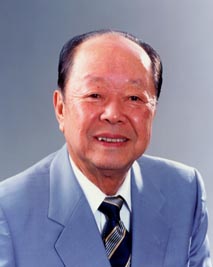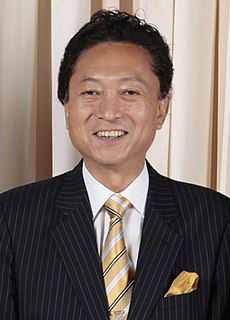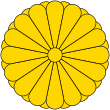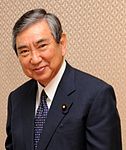
The politics of Japan are conducted in a framework of a multi-party bicameral parliamentary representative democratic constitutional monarchy whereby the Emperor is the ceremonial head of state and the Prime Minister is the head of government and the head of the Cabinet, which directs the executive branch.

The National Diet is Japan's bicameral legislature. It is composed of a lower house called the House of Representatives, and an upper house, called the House of Councillors. Both houses of the Diet are directly elected under parallel voting systems. In addition to passing laws, the Diet is formally responsible for selecting the Prime Minister. The Diet was first convened as the Imperial Diet in 1889 as a result of adopting the Meiji Constitution. The Diet took its current form in 1947 upon the adoption of the post-war constitution, which considers it the highest organ of state power. The National Diet Building is in Nagatachō, Chiyoda, Tokyo.

Masayoshi Ōhira was a Japanese politician and the 43rd Prime Minister of Japan from 7 December 1978 to 12 June 1980. Ōhira was the most recent Japanese prime minister to die in office.

The Social Democratic Party, also known as the Social Democratic Party of Japan and previously as the Japan Socialist Party, is a political party that at various times advocated the establishment of a socialist Japan until 1996. Since its reformation and name change in 1996, it has defined itself as a social-democratic party.
The Japanese political process has three types of elections: general elections to the House of Representatives held every four years, elections to the House of Councillors held every three years to choose one-half of its members, and local elections held every four years for offices in prefectures, cities, and villages. Elections are supervised by election committees at each administrative level under the general direction of the Central Election Administration Committee, an attached organization to the Ministry of Internal Affairs and Communications (MIC). The minimum voting age in Japan's non-compulsory electoral system was reduced from twenty to eighteen years in June 2016. Voters must satisfy a three-month residency requirement before being allowed to cast a ballot.

A general election in Japan was held on 11 September 2005 for all 480 seats of the House of Representatives of Japan, the lower house of the Diet of Japan, almost two years before the end of the term taken from the last election in 2003. Prime Minister Junichiro Koizumi called the election after bills to privatize Japan Post were voted down in the upper house, despite strong opposition within his own Liberal Democratic Party (Japan) (LDP).

The New Party Nippon is a Japanese political party formed on August 21, 2005. The party is headed by the former Nagano governor Yasuo Tanaka, and includes Diet members Kōki Kobayashi, Takashi Aoyama, Makoto Taki, and Hiroyuki Arai, who left the Liberal Democratic Party in opposition to Prime Minister Junichiro Koizumi’s postal privatization drive.

General elections were held in Japan on July 18, 1993 to elect the House of Representatives. The Liberal Democratic Party (LDP), in power since 1955, lost their majority in parliament. An eight-party coalition government was formed and headed by Morihiro Hosokawa, the leader of the Japan New Party (JNP).

House of Councillors elections were held in Japan on July 8, 1956 electing half the seats in the House plus two vacant seats in the other half. The Liberal Democratic Party won the most seats, but failed to win a majority. It was the first national election under the 1955 System, approximately a two party system of Ichirō Hatoyama's Liberal Democratic Party (LDP) that was created in the "conservative merger" of 1955 and Suzuki Mosaburō's reunified Japan Socialist Party (JSP). The later dominant LDP failed to win a majority.

General elections were held in Japan on 22 June 1980. They were the result of a vote of no confidence brought by the Japan Socialist Party (JSP) on 16 May regarding corruption and rises in public utility charges as reasons for the House of Representatives of Japan to withdraw its backing from the government.

A general election for the Japanese House of Representatives was held on August 30, 2009. The opposition Democratic Party (DPJ) defeated the ruling coalition in a sweeping victory, winning 221 of the 300 electoral districts and receiving 42.4% of the proportional block votes for another 87 seats, a total of 308 seats to only 119 for the LDP.

A general election was held in Japan on 16 December 2012. Voters gave the Liberal Democratic Party a landslide victory, ejecting the Democratic Party from power after three years. It was the fourth worst defeat suffered by a ruling party in Japanese history.

The New Renaissance Party was a minor political party in Japan.
People's Life First was a short-lived political party in Japan. It had 37 out of the 480 seats in the House of Representatives, and 12 in the 242-member House of Councillors. On 28 November 2012, the party merged into Governor of Shiga Yukiko Kada's Japan Future Party based in Ōtsu.

The Party for Japanese Kokoro, 日本のこころを大切にする党 is a Japanese political party. It was formed as the Party for Future Generations on 1 August 2014 by a group of Diet members led by Shintarō Ishihara. The party adopted its current name in December 2015.

The 24th regular election of members of the House of Councillors was held on Sunday 10 July 2016 to elect 121 of the 242 members of the House of Councillors, the upper house of the 717-member bicameral National Diet of Japan, for a term of six years. As a result of the election, the LDP/Komeito coalition gained ten seats for a total of 146, the largest coalition achieved since the size of the house was set at 242 seats.

The 25th regular election of members of the House of Councillors will be held on July 2019 to elect 124 of the 245 members of the House of Councillors, the upper house of the then 710-member bicameral National Diet of Japan, for a term of six years.























